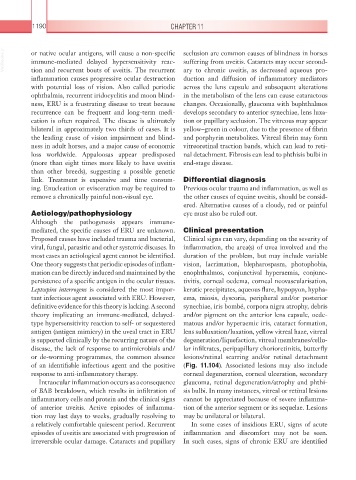Page 1215 - Equine Clinical Medicine, Surgery and Reproduction, 2nd Edition
P. 1215
1190 CHAPTER 11
VetBooks.ir or native ocular antigens, will cause a non-specific seclusion are common causes of blindness in horses
suffering from uveitis. Cataracts may occur second-
immune-mediated delayed hypersensitivity reac-
tion and recurrent bouts of uveitis. The recurrent
duction and diffusion of inflammatory mediators
inflammation causes progressive ocular destruction ary to chronic uveitis, as decreased aqueous pro-
with potential loss of vision. Also called periodic across the lens capsule and subsequent alterations
ophthalmia, recurrent iridocyclitis and moon blind- in the metabolism of the lens can cause cataractous
ness, ERU is a frustrating disease to treat because changes. Occasionally, glaucoma with buphthalmos
recurrence can be frequent and long-term medi- develops secondary to anterior synechiae, lens luxa-
cation is often required. The disease is ultimately tion or pupillary seclusion. The vitreous may appear
bilateral in approximately two thirds of cases. It is yellow–green in colour, due to the presence of fibrin
the leading cause of vision impairment and blind- and porphyrin metabolites. Vitreal fibrin may form
ness in adult horses, and a major cause of economic vitreoretinal traction bands, which can lead to reti-
loss worldwide. Appaloosas appear predisposed nal detachment. Fibrosis can lead to phthisis bulbi in
(more than eight times more likely to have uveitis end-stage disease.
than other breeds), suggesting a possible genetic
link. Treatment is expensive and time consum- Differential diagnosis
ing. Enucleation or evisceration may be required to Previous ocular trauma and inflammation, as well as
remove a chronically painful non-visual eye. the other causes of equine uveitis, should be consid-
ered. Alternative causes of a cloudy, red or painful
Aetiology/pathophysiology eye must also be ruled out.
Although the pathogenesis appears immune-
mediated, the specific causes of ERU are unknown. Clinical presentation
Proposed causes have included trauma and bacterial, Clinical signs can vary, depending on the severity of
viral, fungal, parasitic and other systemic diseases. In inflammation, the area(s) of uvea involved and the
most cases an aetiological agent cannot be identified. duration of the problem, but may include variable
One theory suggests that periodic episodes of inflam- vision, lacrimation, blepharospasm, photophobia,
mation can be directly induced and maintained by the enophthalmos, conjunctival hyperaemia, conjunc-
persistence of a specific antigen in the ocular tissues. tivitis, corneal oedema, corneal neovascularisation,
Leptospira interrogens is considered the most impor- keratic precipitates, aqueous flare, hypopyon, hypha-
tant infectious agent associated with ERU. However, ema, miosis, dyscoria, peripheral and/or posterior
definitive evidence for this theory is lacking. A second synechiae, iris bombé, corpora nigra atrophy, debris
theory implicating an immune-mediated, delayed- and/or pigment on the anterior lens capsule, oede-
type hypersensitivity reaction to self- or sequestered matous and/or hyperaemic iris, cataract formation,
antigen (antigen mimicry) in the uveal tract in ERU lens subluxation/luxation, yellow vitreal haze, vitreal
is supported clinically by the recurring nature of the degeneration/liquefaction, vitreal membranes/cellu-
disease, the lack of response to antimicrobials and/ lar infiltrates, peripapillary chorioretinitis, butterfly
or de-worming programmes, the common absence lesions/retinal scarring and/or retinal detachment
of an identifiable infectious agent and the positive (Fig. 11.104). Associated lesions may also include
response to anti-inflammatory therapy. corneal degeneration, corneal ulceration, secondary
Intraocular inflammation occurs as a consequence glaucoma, retinal degeneration/atrophy and phthi-
of BAB breakdown, which results in infiltration of sis bulbi. In many instances, vitreal or retinal lesions
inflammatory cells and protein and the clinical signs cannot be appreciated because of severe inflamma-
of anterior uveitis. Active episodes of inflamma- tion of the anterior segment or its sequelae. Lesions
tion may last days to weeks, gradually resolving to may be unilateral or bilateral.
a relatively comfortable quiescent period. Recurrent In some cases of insidious ERU, signs of acute
episodes of uveitis are associated with progression of inflammation and discomfort may not be seen.
irreversible ocular damage. Cataracts and pupillary In such cases, signs of chronic ERU are identified

